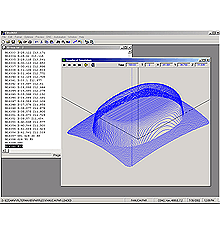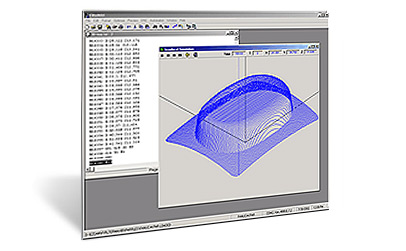
FilterMAX converts point-to-point G-code toolpaths to tangent arc moves or NURBS, resulting in files that are up to 98% shorter. Instead of cutting thousands of linear segments, the machine will cut tangent arcs, giving smoother surface finishes. Small linear moves can slow down a CNC Control's processing time significantly, arc moves generated by FilterMAX eliminate this delay allowing the machine to run much faster.
Download Trial Version NowDownload Trial Version Now

Feedrates can also be optimized for sharp corner deceleration. Angle between every G1/G2/G3 move is calculated. If this angle is bigger than user defined “Corner Angle” threshold then fillet radius and feedrate slowdown modifications are applied.
Optimized code can be graphically simulated one move at a time or all at once in the preview window. NC toolpaths can also be converted to DXF format using the Convert to DXF feature.
Feature List
- Converts toolpaths to tangent arcs, Nurbs, or FANUC 3D Arcs formats
- Optimizes feedrates at corners for fastest machining while holding tolerances
- Toolpath Backplotting
- Machining Time Estimator
- CNC Communications utility (Multi DNC)
- Accepts G-code and other languages
- Advanced NC Text Editor with BASIC macro language
- Convert toolpaths to DXF format
- Easy to Use – just specify your NC file and tolerance
- Integrated menus and processing for WorkNC users
Product Details
FilterMAX converts point-to-point G-code toolpaths into tangent arc moves or NURBS for CNC milling of molds and other surfaces. File size is reduced an average of 85%, feedrates can be tripled, and part finish is dramatically improved.
Feedrates can also be optimized for sharp corner deceleration. Angle between every G1/G2/G3 move is calculated. If this angle is bigger than “Corner Angle” then fillet radius and feedrate slowdown modifications are applied. First software tries to insert a fillet with “Max Corner Radius”. If this fillet can not be inserted then other fillet radii between “Max Corner Radius” and “Min Corner Radius” are tried. If a successful radius is found then the distance between the inserted fillet circle and corner point is calculated. If this distance is less than “Corner Tolerance” then fillet is output into the G-Code file. If fillet is in XY plane then G2/G3 format is used. For 3D fillets multiple G1 moves are used. If Fanuc 3D Arc is available then 3D fillets are output in Fanuc 3D arc format. As second operation, feedrate modification is applied depending on the fillet radius from the first operation. If no fillet could be inserted then “Min Corner Feed” is selected. Otherwise a feedrate between “Max Corner Feed” and “Min Corner Feed” is selected depending on the fillet radius.
Shorter NC Files
A typical toolpath for machining a surface consists of thousands of small, straight-line moves that approximate the surface within a specified chordal tolerance. FilterMAX converts these small linear moves into tangent arc moves, resulting in a file that is up to 98% shorter.
Smoother Finish
Instead of cutting thousands of linear segments, your machine will now cut tangent arcs, giving you the smoothest possible finish for molds, dies and other sculpted surface parts.
Faster Machining
When linear moves are very short, NC control processing time can slow the rate of cutting significantly. The arc moves created by FilterMAX eliminate this delay, allowing your machine to run up to four times faster. In addition, the feedrate modification option allows you to slow down for sharp corners and speed up where specified tolerances can be held. FilterMAX will insert a slower feed rate at the optimal distance before a corner based on the deceleration rate of your machine.
Improved Accuracy
In most cases FilterMAX will increase the accuracy of your toolpath with respect to the original surface. The straight-line approximation of the original surface causes a “chordal deviation” which is nearly eliminated in fitting arcs to the toolpath.
What kinds of toolpaths can FilterMAX optimize?
FilterMAX will convert any G-code tool passes which are parallel to the X, Y or Z axis (2 axis moves) and are within a user-specified tolerance. Any simultaneous three-axis moves or other existing arc moves are left untouched unless NURBS/3Darc conversion is desired. A file with only a small portion of surface machining can be converted safely as the non-surface machining portions will not be changed.



